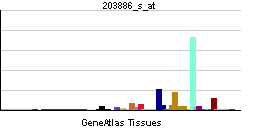FBLN2
| Fibulin 2 | |||||||||
|---|---|---|---|---|---|---|---|---|---|
| Identifiers | |||||||||
| Symbols | FBLN2 ; | ||||||||
| External IDs | Template:OMIM5 Template:MGI HomoloGene: 1514 | ||||||||
| |||||||||
| RNA expression pattern | |||||||||
 | |||||||||
| More reference expression data | |||||||||
| Orthologs | |||||||||
| Template:GNF Ortholog box | |||||||||
| Species | Human | Mouse | |||||||
| Entrez | n/a | n/a | |||||||
| Ensembl | n/a | n/a | |||||||
| UniProt | n/a | n/a | |||||||
| RefSeq (mRNA) | n/a | n/a | |||||||
| RefSeq (protein) | n/a | n/a | |||||||
| Location (UCSC) | n/a | n/a | |||||||
| PubMed search | n/a | n/a | |||||||
Fibulin 2, also known as FBLN2, is a human gene.[1]
This gene encodes an extracellular matrix protein, which belongs to the fibulin family. This protein binds various extracellular ligands and calcium. It may play a role during organ development, in particular, during the differentiation of heart, skeletal and neuronal structures. Alternatively spliced transcript variants encoding different isoforms have been identified.[1]
References
Further reading
- Sasaki T, Göhring W, Pan TC; et al. (1996). "Binding of mouse and human fibulin-2 to extracellular matrix ligands". J. Mol. Biol. 254 (5): 892–9. doi:10.1006/jmbi.1995.0664. PMID 7500359.
- Zhang RZ, Pan TC, Zhang ZY; et al. (1995). "Fibulin-2 (FBLN2): human cDNA sequence, mRNA expression, and mapping of the gene on human and mouse chromosomes". Genomics. 22 (2): 425–30. doi:10.1006/geno.1994.1404. PMID 7806230.
- Pan TC, Sasaki T, Zhang RZ; et al. (1994). "Structure and expression of fibulin-2, a novel extracellular matrix protein with multiple EGF-like repeats and consensus motifs for calcium binding". J. Cell Biol. 123 (5): 1269–77. PMID 8245130.
- Reinhardt DP, Sasaki T, Dzamba BJ; et al. (1996). "Fibrillin-1 and fibulin-2 interact and are colocalized in some tissues". J. Biol. Chem. 271 (32): 19489–96. PMID 8702639.
- Miosge N, Götz W, Sasaki T; et al. (1996). "The extracellular matrix proteins fibulin-1 and fibulin-2 in the early human embryo". Histochem. J. 28 (2): 109–16. PMID 8737292.
- Collod G, Chu ML, Sasaki T; et al. (1997). "Fibulin-2: genetic mapping and exclusion as a candidate gene in Marfan syndrome type 2". Eur. J. Hum. Genet. 4 (5): 292–5. PMID 8946175.
- Utani A, Nomizu M, Yamada Y (1997). "Fibulin-2 binds to the short arms of laminin-5 and laminin-1 via conserved amino acid sequences". J. Biol. Chem. 272 (5): 2814–20. PMID 9006922.
- Sasaki T, Mann K, Wiedemann H; et al. (1997). "Dimer model for the microfibrillar protein fibulin-2 and identification of the connecting disulfide bridge". EMBO J. 16 (11): 3035–43. doi:10.1093/emboj/16.11.3035. PMID 9214621.
- Brown JC, Sasaki T, Göhring W; et al. (1998). "The C-terminal domain V of perlecan promotes beta1 integrin-mediated cell adhesion, binds heparin, nidogen and fibulin-2 and can be modified by glycosaminoglycans". Eur. J. Biochem. 250 (1): 39–46. PMID 9431988.
- Raghunath M, Tschödrich-Rotter M, Sasaki T; et al. (1999). "Confocal laser scanning analysis of the association of fibulin-2 with fibrillin-1 and fibronectin define different stages of skin regeneration". J. Invest. Dermatol. 112 (1): 97–101. doi:10.1046/j.1523-1747.1999.00483.x. PMID 9886271.
- Kuivaniemi H, Marshall A, Ganguly A; et al. (1999). "Fibulin-2 exhibits high degree of variability, but no structural changes concordant with abdominal aortic aneurysms". Eur. J. Hum. Genet. 6 (6): 642–6. doi:10.1038/sj.ejhg.5200245. PMID 9887386.
- Sasaki T, Göhring W, Miosge N; et al. (1999). "Tropoelastin binding to fibulins, nidogen-2 and other extracellular matrix proteins". FEBS Lett. 460 (2): 280–4. PMID 10544250.
- Gu YC, Nilsson K, Eng H, Ekblom M (2000). "Association of extracellular matrix proteins fibulin-1 and fibulin-2 with fibronectin in bone marrow stroma". Br. J. Haematol. 109 (2): 305–13. PMID 10848816.
- Talts JF, Sasaki T, Miosge N; et al. (2001). "Structural and functional analysis of the recombinant G domain of the laminin alpha4 chain and its proteolytic processing in tissues". J. Biol. Chem. 275 (45): 35192–9. doi:10.1074/jbc.M003261200. PMID 10934193.
- Olin AI, Mörgelin M, Sasaki T; et al. (2001). "The proteoglycans aggrecan and Versican form networks with fibulin-2 through their lectin domain binding". J. Biol. Chem. 276 (2): 1253–61. doi:10.1074/jbc.M006783200. PMID 11038354.
- Hopf M, Göhring W, Mann K, Timpl R (2001). "Mapping of binding sites for nidogens, fibulin-2, fibronectin and heparin to different IG modules of perlecan". J. Mol. Biol. 311 (3): 529–41. doi:10.1006/jmbi.2001.4878. PMID 11493006.
- Hunzelmann N, Nischt R, Brenneisen P; et al. (2001). "Increased deposition of fibulin-2 in solar elastosis and its colocalization with elastic fibres". Br. J. Dermatol. 145 (2): 217–22. PMID 11531782.
- Sasaki T, Göhring W, Mann K; et al. (2002). "Short arm region of laminin-5 gamma2 chain: structure, mechanism of processing and binding to heparin and proteins". J. Mol. Biol. 314 (4): 751–63. doi:10.1006/jmbi.2001.5176. PMID 11733994.
- Bengtsson E, Mörgelin M, Sasaki T; et al. (2002). "The leucine-rich repeat protein PRELP binds perlecan and collagens and may function as a basement membrane anchor". J. Biol. Chem. 277 (17): 15061–8. doi:10.1074/jbc.M108285200. PMID 11847210.
- Strausberg RL, Feingold EA, Grouse LH; et al. (2003). "Generation and initial analysis of more than 15,000 full-length human and mouse cDNA sequences". Proc. Natl. Acad. Sci. U.S.A. 99 (26): 16899–903. doi:10.1073/pnas.242603899. PMID 12477932.
| This protein-related article is a stub. You can help Wikipedia by expanding it. |